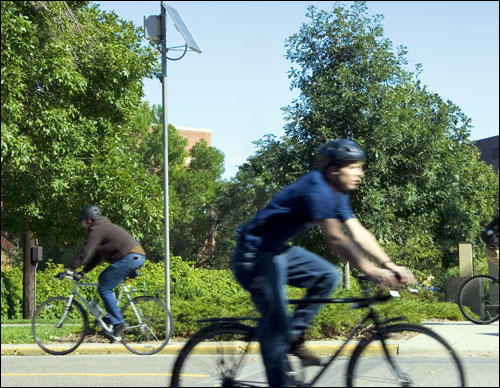Since Jan. 1, 2009, employers that provide bicycle parking—or other support for workers who pedal their way to the office—have been able to deduct up to $20 a month per participating employee from their own taxable income.
Dero Bike Racks, a Minneapolis, Minn., manufacturer of racks and other bike-storage systems, has introduced an RFID system called Zap, in order to provide companies with a means of tracking and verifying their employees’ practice of commuting to work by bicycle. By deploying Zap, employers can have an automated means of doling out the $20 monthly stipend awarded to bike-riding commuters as laid out in section 211 of the Emergency Economic Stabilization Act of 2008 (H. R. 1424). The stipend is meant to defray employee costs for bicycle maintenance and accessories, such as locks—and since it is tax-free, the award is meant to encourage employers to provide adequate bike parking, as well as showers for staff members who ride bicycles.
There is no mandated means by which companies must track which of their employees ride to work and have thus earned the stipend—nor is there a delegated number of days per week that a worker must ride in order to qualify. The law merely states that a qualifying employee “regularly uses the bicycle for a substantial portion of the travel between the employee’s residence and place of employment.”
Some companies simply have their workers keep a manual record that they submit to their supervisors.
Dero hopes employers will purchase the Zap system, because it would provide an automated, low-maintenance means of tracking which employees ride to work, and how often, and because it would offer a platform by which companies might also offer incentive rewards to staff members who, for instance, ride to work every day of the week.
Mike Anderson, Dero’s product manager, says his company also hopes that health-insurance firms may subsidize the costs of the Zap system for businesses that are policy holders, as a means of encouraging employees of these companies to maintain better health (and, thus, lower health-care costs) through the benefits of biking regularly.
Zap uses passive ultrahigh-frequency (UHF) tags complying with the EPC Gen 2/ISO 18000-6c standard.
“We have gone through a number of different tag designs,” Anderson says, “but the final one is a tamper-evident tag that mounts onto a wheel spoke and will stop working if someone attempts to remove it from the spoke.” The tag was designed to be tamper-proof in order to discourage employees from tricking the system by driving to work and then, after getting out of their car, carrying a tag as they walk past a solar-powered read station on their way into the building.
The interrogators can reliably read the tags from approximately 35 feet, Anderson says. Each reader, deployed near a workplace’s bike stand, issues an audio and visual alert to let the user know his or her tag has been successfully read. What’s more, the software that manages the interrogators filters out duplicate reads so that only one credit is earned each day.
According to Anderson, Dero already utilizes the Zap system to determine which of its own employees ride to work and should, thus, receive the monthly stipend. Since the software that tracks the tag readers is Web-based, Zap allows its employees to view a dashboard that totals the company-wide bike-riding records—this can be seen on Dero’s Zap page—as well as view their individual records.
In addition, Dero is currently operating a small Zap pilot project at a local university. There are currently about 40 people involved in this pilot, but Anderson expects that number to grow as soon as the final design of the Zap RFID tag is ready for distribution at the school.
The Zap application employs RFID technology originally developed by a company called Freiker (short for FREquent bIKER). Rob Nagler, a computer engineer and father who lives in Boulder, Colo., developed this RFID-based system as a means of providing incentives to get more students at his children’s’ school to ride their bicycles to and from classes on a daily basis (see RFID Motivates Schoolkids to Bike It). Freiker has since changed hands; its new name is Boltage. The Boltage system is now in use at more than a dozen schools throughout the United States and Canada.
The students are issued EPC Gen 2 RFID tags that can be attached to bike helmets or back packs. Upon entering and leaving the school campus, a student carrying the tag passes under a reading station, where a solar-powered RFID reader collects the unique ID encoded to that tag, and emits audio and visual signals to let the student know that the tag has been read. Back-end software maintains a database containing the date and time of the tag reads—each of which earns the student a point. Periodically, students with the most points win prizes.


